
Ammonoids are a group of extinct marine mollusc animals in the subclass Ammonoidea of the class Cephalopoda. These molluscs, commonly referred to as ammonites, are more closely related to living coleoids than they are to shelled nautiloids such as the living Nautilus species. The earliest ammonites appeared during the Devonian, and the last species either vanished in the Cretaceous–Paleogene extinction event, or shortly after during the Danian epoch of the Paleocene.
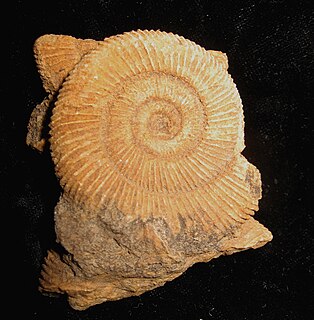
Dactylioceras was a widespread genus of ammonites from the Lower Jurassic period, approximately 180 million years ago (mya).
In the geologic timescale the Bathonian is an age and stage of the Middle Jurassic. It lasted from approximately 168.3 Ma to around 166.1 Ma. The Bathonian Age succeeds the Bajocian Age and precedes the Callovian Age.
In the geological timescale, the Berriasian is an age/stage of the Early/Lower Cretaceous. It is the oldest subdivision in the entire Cretaceous. It has been taken to span the time between 145.0 ± 4.0 Ma and 139.8 ± 3.0 Ma. The Berriasian succeeds the Tithonian and precedes the Valanginian.
In the geologic timescale, the Valanginian is an age or stage of the Early or Lower Cretaceous. It spans between 139.8 ± 3.0 Ma and 132.9 ± 2.0 Ma. The Valanginian Stage succeeds the Berriasian Stage of the Lower Cretaceous and precedes the Hauterivian Stage of the Lower Cretaceous.
In the geologic timescale, the Callovian is an age and stage in the Middle Jurassic, lasting between 166.1 ± 4.0 Ma and 163.5 ± 4.0 Ma. It is the last stage of the Middle Jurassic, following the Bathonian and preceding the Oxfordian.

In the geologic timescale, the Sinemurian is an age and stage in the Early or Lower Jurassic Epoch or Series. It spans the time between 199.3 ± 2 Ma and 190.8 ± 1.5 Ma. The Sinemurian is preceded by the Hettangian and is followed by the Pliensbachian.
The Pliensbachian is an age of the geologic timescale and stage in the stratigraphic column. It is part of the Early or Lower Jurassic Epoch or Series and spans the time between 190.8 ± 1.5 Ma and 182.7 ± 1.5 Ma. The Pliensbachian is preceded by the Sinemurian and followed by the Toarcian.
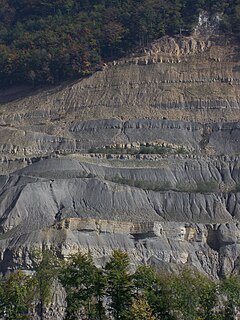
The Oxfordian is, in the ICS' geologic timescale, the earliest age of the Late Jurassic Epoch, or the lowest stage of the Upper Jurassic Series. It spans the time between 163.5 ± 4 Ma and 157.3 ± 4 Ma. The Oxfordian is preceded by the Callovian and is followed by the Kimmeridgian.
In the geologic timescale, the Kimmeridgian is an age in the Late Jurassic Epoch and a stage in the Upper Jurassic Series. It spans the time between 157.3 ± 1.0 Ma and 152.1 ± 0.9 Ma. The Kimmeridgian follows the Oxfordian and precedes the Tithonian.
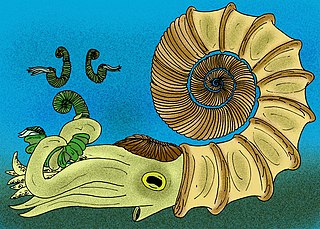
Tropaeum is an extinct genus of ammonites found throughout the oceans of the world during the Early Cretaceous. As with many other members of the family Ancyloceratidae, there was a trend among species within this genus to uncoil somewhat, in a very similar manner to the genus Lytoceras. The largest species, T. imperator of Australia, had a shell a little over one meter in diameter.
Abbasites is an extinct genus of ammonites from the early Middle Jurassic epoch, included in the ammonitid family Erycitidae.

Psiloceras is an extinct genus of ammonite. Psiloceras is among the earliest known Jurassic ammonites, and the appearance of the earliest Psiloceras species form the definition for the base of the Jurassic. Unlike most earlier ammonites, which had complex shell shapes and ornamentation, Psiloceras had a smooth shell.
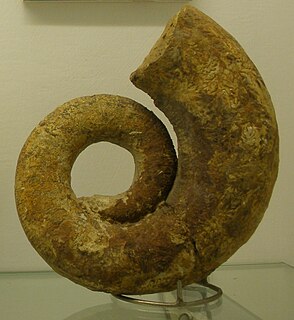
Lytoceras is an ammonite genus that was extant during most of the Jurassic and Cretaceous periods, and is the type genus for the family Lytoceratidae. These cephalopods were fast-moving nektonic carnivores.
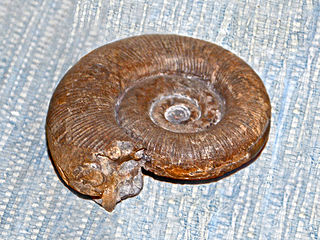
Lytoceras batesi is an ammonite species belonging to the family Lytoceratidae. These cephalopods were fast-moving nektonic carnivores. They lived in the Cretaceous period.
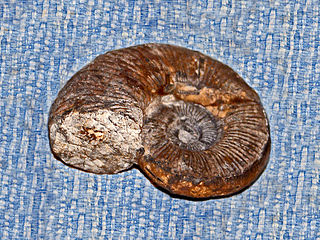
Lytoceras fimbriatum is an ammonite species belonging to the family Lytoceratidae. These cephalopods were fast-moving nektonic carnivores. They lived in the Jurassic period.

Lytoceras eudesianum is an ammonite species belonging to the family Lytoceratidae. These fast-moving nektonic carnivores lived from the Bajocian age to the Bathonian age of the Middle Jurassic.

Padillasaurus is an extinct genus of titanosauriform sauropod known from the Early Cretaceous Paja Formation in Colombia. It contains a single species, Padillasaurus leivaensis, known only from a single partial axial skeleton. Initially described as a brachiosaurid, it was considered to be the first South American brachiosaurid ever discovered and named. Before its discovery, the only known brachiosaurid material on the continent was very fragmentary and from the Jurassic period. However, a more recent study finds it to be a basal somphospondylan.

Lytoceras sutile is an ammonite species belonging to the family Lytoceratidae. These cephalopods were fast-moving nektonic carnivores.
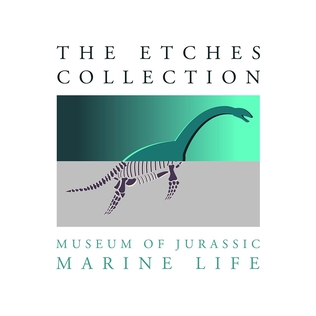
The Etches Collection is an independent fossil museum located in the village of Kimmeridge, Purbeck, Dorset, England. It is based on the lifetime collection of Steve Etches, a fossil hunter for whom some of his finds have been named, from the local area on the Jurassic Coast, an SSI and World Heritage Site, especially around Kimmeridge Bay and the Kimmeridge Ledges.













